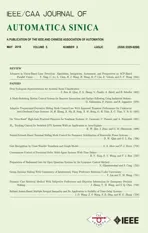Dynamic Case Retrieval Method With Subjective Preferences and Objective Information for Emergency Decision Making
2018-08-11JingZhengYingmingWangandShengqunChen
Jing Zheng,Yingming Wang,and Shengqun Chen
Abstract—Case-based reasoning(CBR)is one of the best methods for generating an effective solution in an emergency.In recent years,some methods for generating emergency alternatives have been included in practical CBR applications,but there have been no in-depth studies of these processes.In this study,we propose a new method for dynamic case retrieval with subjective preferences and objective information,which considers the personal preferences of the decision makers and changes in the attributes of the emergency as the situation develops.First,we present a formula for calculating the case similarity and changing trends in the case considered,where similar cases are obtained.Next,we describe a method for measuring the overall assessment value with respect to similar historical cases,which is obtained by aggregating the case similarity,the utility case similarity,the first response time,and the implementation effect.The subjective preferences and objective information are also integrated in the decision-making process.Finally,we present a case study based on the emergency response to a fire in a highrise building,which illustrates the applicability and feasibility of the proposed method.
I.INTRODUCTION
THE numbers of social,environmental,and medical emergencies have been increasing in recent years,thereby causing losses of life and property,economic disruption,and environmental degradation,which often have significant effects on social development in certain regions.For example,an outbreak of severe acute respiratory syndrome occurred in 2003,followed by H1N1 bird flu in 2009,and H7N9 avian influenza in 2014.When an emergency occurs,a decision maker(DM)is required to generate an alternative to mitigate or minimize any negative effects as soon as possible.Thus,it is important to identify the best method for generating an effective mitigation plan in a short time to facilitate optimum decision making during an emergency.
The methods that have been used to deal with emergency decision-making include multi-attribute risk analysis[1],the group analytic network process approach[2],the fault tree analysis(FTA)-based method[3],case-based reasoning(CBR)[4],distance-based group decision-making[5],the game method[6],the analytic network process[7],and revised PROMETHEE II[8].CBR is used most widely among these various methods.CBR is a process for solving new problems by referring to previous similar cases,which helps the DM to make decisions as quickly as possible based on these precedents.CBR usually includes four steps:1)representing the target case and the historical case;2)retrieving the most similar historical case(s)from the case database;3)adapting the solution to the selected historical cases to the current situation;and 4)updating by adding and deleting the historical case(s)to create a precedent database for solving future problems,if appropriate.Retrieval is regarded as the core of these four steps.
There are many examples of the successful use of CBR,such as Fan et al.[4]used CBR to generate project risk response strategies and emergency alternatives in the case of a gas explosion.Liao et al.[9]applied CBR in the context of environmental emergency preparedness,while Huanget al.[10]applied it to emergency management engineering.Liu et al.[11]used CBR to predict the emergency resource demand.Amailef and Lu[12]applied an ontology-supported CBR approach to emergency responses,while Liu and Yu[13]used CBR to retrieve precedent cases for risk management.As demonstrated by the high number of examples available,CBR is considered to be highly suitable for facilitating emergency decision making.
Previous studies have made significant contributions to the use of CBR during emergency decision making.In some actual situations,the emergency may be changing continuously such as fire hazards and disease infections.Moreover,during decision making processes,the DMs are bounded rationality and they have their own preferences.Thus,it is necessary to consider a special emergency decision-making problem with several distinct characteristics,including dynamic changes in the emergency,the preferences of DMs,and the impacts of alternative responses to the emergency.However,existing decision-making methods based on CBR do not consider the dynamics of the emergency and the preferences of DMs;therefore,it is necessary to further investigate the emergency decision-making problem by considering the characteristics of dynamic change,the preferences of DMs,and alternative implementations.
In order to achieve the aims stated above,we propose a new dynamic case retrieval approach.The proposed method makes three main contributions.First,we incorporate probability into the case representation based on the characteristics of dynamic change and we compute the utility similarity.Probability is a good measure of the possibility of random events.Changes in the emergency’s attributes can be estimated based on the probability[3],[14],[15].Every attribute can have several different states,so the state of the attribute in the next moment can be expressed by the probability of every state.The interval probability can adequately express these potential changes given that the characteristic of uncertainty exists in every emergency.The similarity of the changing trend in the emergency can then be obtained by computing the utility of the interval probability for every attribute.The similarity measurement that incorporates these changes is referred to as the dynamic similarity measurement.Second,we integrate the pairwise comparison matrix and the fuzzy preference matrix into the case retrieval process to express the preferences of DMs.During traditional emergency decision making,the DM is viewed as completely rational,whereas the DM has subjective preferences in practice.Fuzzy and multiplicative preferences are two commonly used methods for characterizing the subjective preferences of a DM[16],which can be expressed as a pairwise comparison matrix and a fuzzy preference matrix,respectively.Finally,the generation of a mitigating strategy is often complicated due to the existence of multiple criteria that affect the effectiveness of the emergency alternative.In this study,we consider the similarity between the target case and historical cases,but we also consider other factors such as the initial response time and the effects of alternative implementations according to the historical cases.Therefore,multi-criteria decision-making methods with integrated subjective preferences and objective information may prove helpful by allowing DMs to generate emergency mitigation strategies.
The remainder of this paper is organized as follows.In Section II,we introduce the emergency decision-making problem.In Section III,we propose the hybrid approach for selecting an optimal historical case from the historical cases library.In Section IV,we present a case study based on a fire in a highrise building.Finally,we give our conclusions in Section V.
II.THE PROBLEM
In this section,we briefly describe the problem of generating the optimum solution in an emergency situation.We suppose that C=(C1,...,Cm)is the set of historical emergency cases and C0is the target emergency case,G=(g1,...,gn)is the set of the attributes,and X=(xij)m×nrepresents the values of attribute gjwith regard to emergency case Ci.Let W=(w1,w2,...,wn)be the weight vector of the attributes,where wjrepresents the weight of attribute gj,0≤wj≤1,
Due to the dynamics of an emergency case,when we apply the CBR method to generate an alternative path,it is not sufficient to only consider case similarity,but instead the similarity of the trends in the changing characteristics of the emergency also needs to be considered.Thus,we use the interval probability with regard to every state of every attribute to represent the trends in an emergency case.Θ =(θ1,θ2,...,θlj)represents the possible state of attributerepresents the interval probability of state θk(k ∈ [1,lj]),which belongs to attribute gjwith regard to emergency case CiInformation related to the historical cases and target case is shown in Table I.Z=(zit)m×4denotes the decision matrix set,where zi1represents the similarity between the historical emergency case Ciand the target case C0,zi2represents the utility similarity of the degree of change in emergency case Ciand C0,zi3represents the initial response time in the historical emergency case Ci,zi4represents the implementation effect of the historical emergency case Ci.V=(v1,v2,v3,v4)is the weight vector of the decision attributes,where νtrepresents the weight of decision attribute,Based on these conditions,we can rank the historical emergency cases and determine the most desirable alternative.
III.THE METHOD
In this section,we propose a dynamic case retrieval method that integrates subjective preferences and objective information for use in emergency decision-making.First,we provide the formula for measuring the emergency case similarity.Second,we provide a measure for calculating the utility similarity of the changing trends during different emergencies.Finally,the most desirable alternative is determined by considering the emergency case similarity,the utility similarity in the changing trends,the initial response time,and the effects of implementing different historical alternatives.In addition,the DM provides his/her preference in terms of the solutions to the emergency and the relative weights for its attributes.The first part of this method is described as follows.
A.Retrieval of the Similar Historical Cases
In this study,we consider two forms of attribute values,i.e.,interval number and fuzzy linguistic variables.
First,we calculate the distance between the attributes for the target case C0and the historical cases Ci.di=(di1,di2,...,din)is the vector of the distance of the attributes,where dijis the distance of attribute gjwith respect to emergency case Ci.When the attribute value xijis an interval number,the formula for calculating dijcan be expressed by

If attribute value xijis a fuzzy linguistic variable,it can be represented by the triangular fuzzy number xij=the set of linguistic variables,then eh(1≤h≤f)can be expressed by

TABLE IINFORMATION RELATED TO THE HISTORICAL CASES AND TARGET CASE
When the fuzzy linguistic variables are represented as a triangular fuzzy number,the formula for dijcan be expressed by

After this process,we use the simple additive weight approach to determine the similarity of the emergency cases.In order to estimate the weight vector W,we use the subjective method with the pairwise comparison matrix based on the relative weights of the attributes,which are provided by the DM.
The multiplicative preference relationship between the relative weights of the attributes can be represented as

where aji=1/aij>0 and aii=1(i,j=1,...,n).
According to Satty’s eigenvector method(EM)[18],we can estimate the weight vector W=(w1,w2,...,wn)Tby solving the following eigenvalue problem:

If the multiplicative preference relation A is a precise/consistent comparison matrix,equation(5)can be transformed as follows:

which indicates that when the DM provides the multiplicative preference relation,the DM should ensure that the multiplicative preference relation is as consistent as possible.
The DMs have a preference in terms of the attribute weights,but they also want the total distance or extent of the emergency case to be minimized.There is no guarantee that the multiplicative preference relations and the minimum of the total distance would lead to the same estimates for the relative attribute weights,so we introduce the following deviation vector[16]:

where H=(ε1,...,εn)Tand I is an n × n unit matrix,in which the elements on the leading diagonal are one and all the others are zero.It is desirable that the absolute value of the deviation variable and the total distance are kept as small as possible,so we construct the following optimization model according to the linear weighted method[19]:
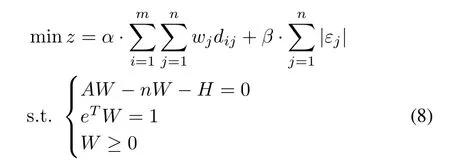
where eT=(1,1,...,1)1×n,and α ≥ 0 and β ≥ 0 represent the weight of the total distance and the absolute value of the deviation variable,respectively,and α+β =1.In order to solve this nonlinear model,we introduce the following deviation variables:


Let W∗=be the optimal weight estimate generated by model(10).Based on this weight,the similarity between the current emergency case and historical cases can be computed using the following formula.

According to the theory of case-based decision making[20]−[22],historical emergency cases that share high similarity with the target emergency case are selected as alternatives.Thus,we set a similarity threshold ξ,ξ∈ [min{Sim(C0,Ci)},max{Sim(C0,Ci)}],where a greater value for ξ indicates a higher similarity requirement.If Sim(C0,Ci)≥ ξ is satisfied by the emergency case,the historical cases will be selected as the library of candidate alternative cases.B.Utility Similarity Measure for Changing Trends in the Emergency Case
Definition 1[23]:If[a,b]is an interval number and[0,1]is the function with the following dynamics:
1)ρ(0)=0;2) ρ(1)=1;3)if x > y,then ρ(x)≥ ρ(y).
Thus,if the function f is referred to as the COWA operator,ρ can be referred to as the basic unit-interval monotonic function.
According to the COWA operator,we determine the utility measure for every attribute as follows.
First,we determine the function■10ρ(y)dy.According to Definition 1,we obtain the interval probabilityas follows:
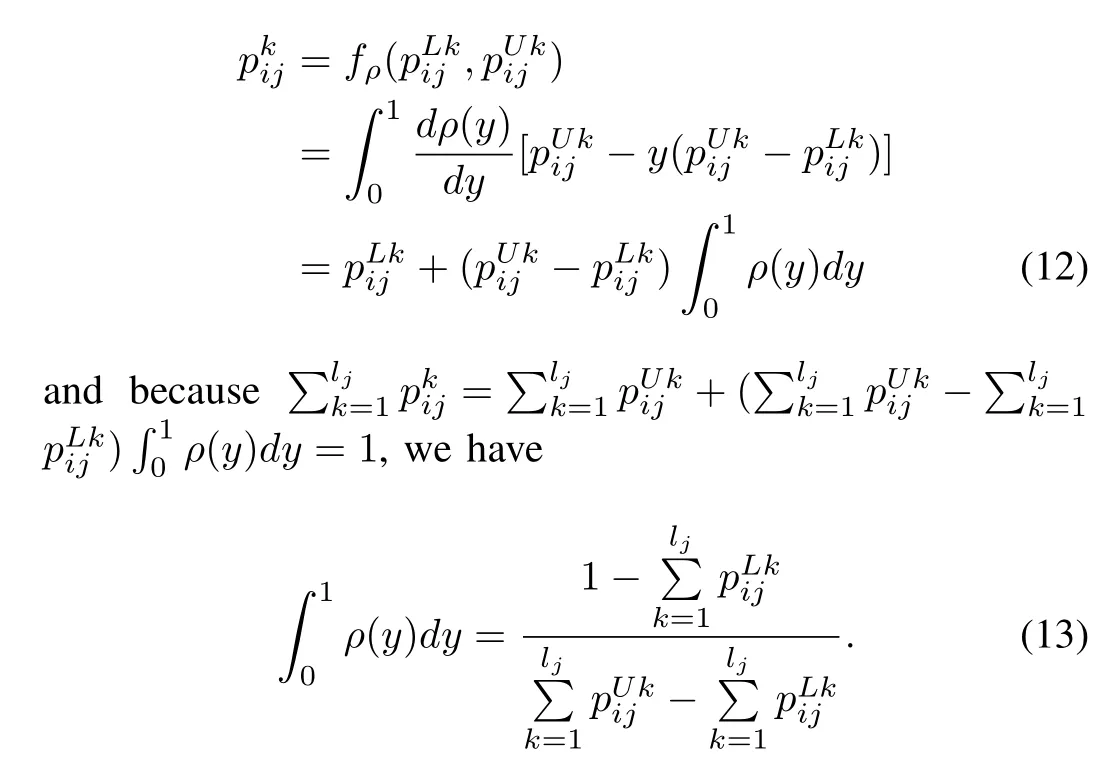
Second,according to Definition 1 and the function(y)dy,we change the interval probabilitiesandinto the point probabilitiesand,as follows:


Finally,the utility similarity for the changing trend in the emergency case is calculated by

which yields the outcome:Sim0(C0,Ci)∈[0,1].
C.Generation of the Optimal Emergency Alternative
To obtain the most desirable alternative to the emergency,we consider the case similarity,the initial response time,and the effects of implementing the historical case solution.The initial response time is one of the most important factors during emergency decision making.In order to make a more powerful decision in an emergency,we should consider the effects of different solutions to historical cases.The method proposed for selecting the most desirable historical emergency case is explained as follows.
Due to incommensurability among attributes,the decision matrix Z=(zit)m×4needs to be normalized.The most commonly used normalization method is as follows:

Next,in some situations,DMs usually prefer to provide a fuzzy preference relation based on an alternative decision,which is given according to the DMs experience and professional knowledge,as studied previously[16].In order to determine the best alternative,we need to consider the DM’s preferences.Given that the DM provides a fuzzy preference matrix based on decision alternatives and a pairwise comparison matrix for the relative weights of the attributes,we combine these together into an integrated decision model to generate overall estimates of the relative weights of the attributes.
The multiplicative preference relation based on the relative weights of the attributes is represented by matrix B using(4).The fuzzy preference relation based on the decision alternatives provided by a DM is represented by

where qij+qji=1,qii=0.5,and qij≥0(i,j=1,...,m).
Thus,we obtain

Based on matrices B and F,we construct the following optimization model using the method of Wang and Parkan[16]to estimate the relative attribute weights:

Let V∗=(,...,)Tbe the optimal weight estimate generated from model(22).Thus,the overall weighted assessment value Uifor each alternative can be computed as follows.

Subsequently,the hybrid similarities can be calculated using(23)and Ui∈[0,1].The historical case is more effective when the value of Uiis greater.Therefore,we can select the best alternative according to the value of Ui.
IV.CASE STUDY
In this section,we present a case study based on an emergency response to a fire,which illustrates the feasibility and validity of the proposed method.First,we introduce the high rise fire scenario.The dynamic retrieval method is then used to obtain the optimal historical case.In addition,a sensitivity analysis is presented,which shows the impact on retrieval of the factors considered.
A.Introduction of the Case
In recent years,increasingly higher buildings have exacerbated the risk of fire hazards in China.Thus,generating an effective emergency plan to respond to a high-rise fire has attracted significant social attention.In our scenario,a fire control center receives an alarm about a fire in a high-rise building.The fire situation(g1)is deemed to be severe,with casualties(g2)of 15 to 18 people,a damaged area(g3)measuring between 65m2and 75m2,and property damage(g4)of RMB 0.08million to RMB 0.1million.According to the case library,there are 10 similar historical cases(C1,C2,...,C10),as shown in Table II,which considers four attributes.Table II also shows that the attribute value for the fire situation with respect to the linguistic variables from the pre-established fuzzy linguistic variable set E,where E=(ES:extremely severe,VS:very severe,S:severe,SS:somewhat severe,NS:not severe,N:normal,G:good).
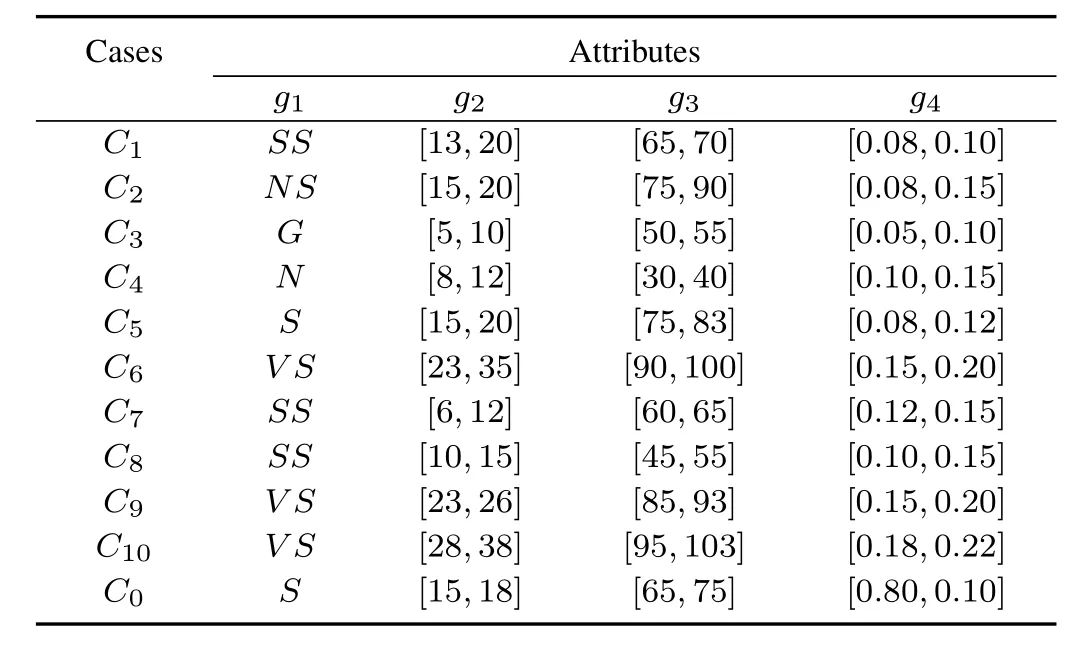
TABLE IIATTRIBUTE VALUES FOR THE HISTORICAL CASES AND TARGET CASE
With respect to the changing trends in the emergency,the interval probability of every attribute is shown in Table III.Data from the initial response time zi3and the effect of implementing the historical case zi4are shown in Table IV,where the attribute value for the implementation effect comprises linguistic variables from the pre-established fuzzy linguistic variable set T,where T=(VS:very severe,S:severe,N:normal,G:good,VG:very good).In addition,the DM provides the pairwise comparison matrix based on the relative weights of attributes with regard to the emergency cases,as follows:
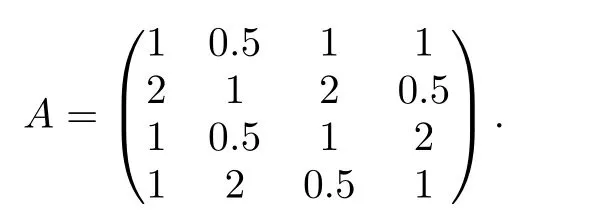
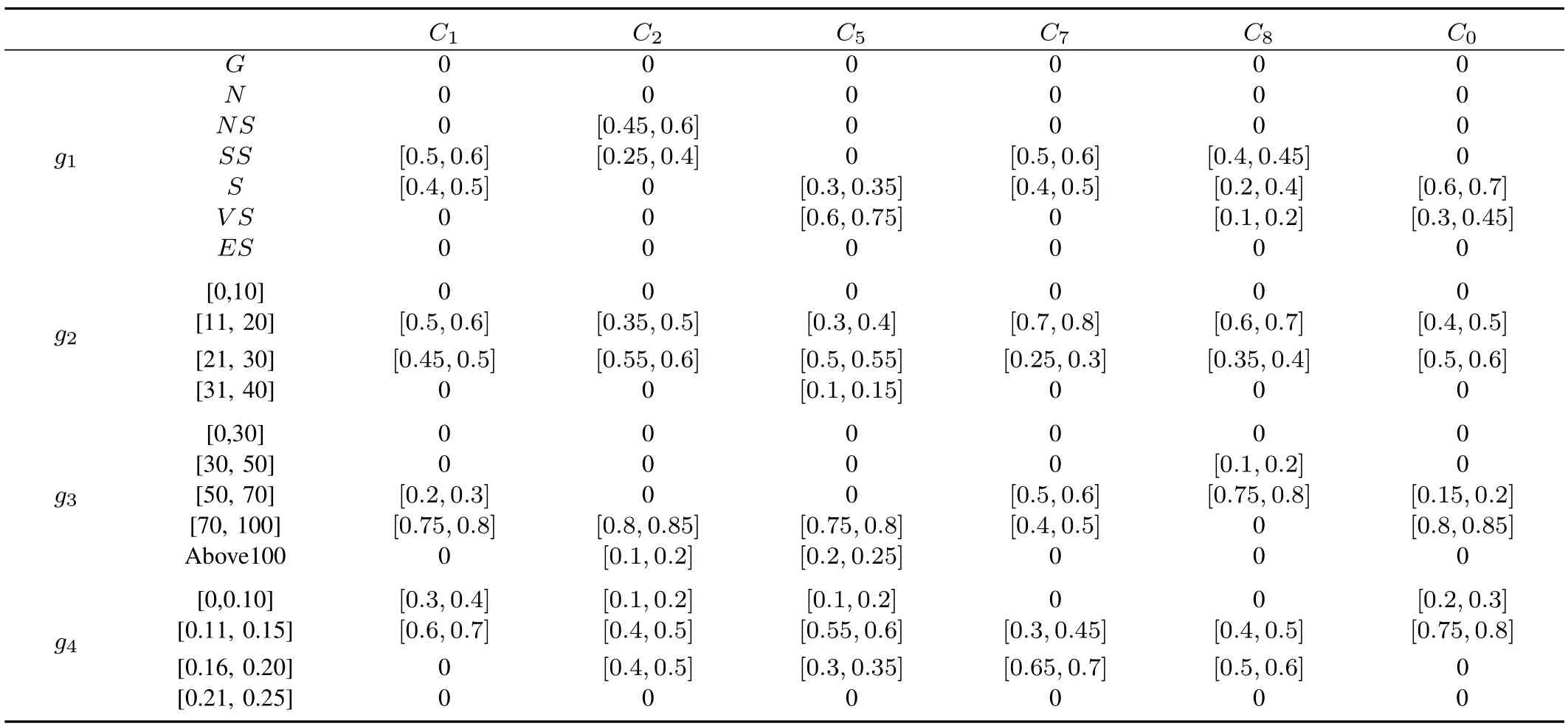
TABLE IIICHANGES IN THE INFORMATION FOR EVERY ATTRIBUTE
B.Generating an Optimal Emergency Alternative Using th Proposed Method
e
To solve the problem described above,we used the proposed method to determine the most desirable alternative to the emergency.The computation processes and results are given as follows.
Step 1:Compute the similarity between the historical cases and the target case.For attributes in the form of interval numbers,i.e.,g2,g3,g4,the distance between attributes dijwas calculated using(1).For attributes in the form of fuzzy linguistic variables,i.e.,g1,the fuzzy linguistic variables were transformed into triangular fuzzy numbers using(2)and the fuzzy linguistic variables in set E were also transformed,i.e.,e0=(0,0,0.17),e1=(0,0.17,0.33),e2=(0.17,0.33,0.5),e3=(0.33,05,0.67),e4=(0.5,0.67,0.83),e5=(0.67,0.83,1),and e6=(0.83,1,1).Next,we calculated the distance between the attributes dijusing(3)and the results obtained are presented in Table V.
The weight vector W∗=(w∗1,w∗2,...,w∗n)Tcan be estimated according to the GP model(10).For different combinations of the deviation variable and the total emergency case distance,Table V shows the estimated optimal relative weights for the four attributes.The results in Table V leads us to expect that for(α,β)=(1,0),(α,β)=(0.2,0.8),and(α,β)=(0,1),the other weights are all W∗=(0.2114,0.3084,0.1749,0.3052),so we set these as the optimal attribute weights.The emergency case similarity Sim(C0,Ci)was then calculated using(11)and the results are shown in Table VI.

TABLE IVINITIAL RESPONSE TIMES AND IMPLEMENTATION EFFECTS

TABLE VOPTIMAL RELATIVE WEIGHTS FOR THE EMERGENCY ATTRIBUTES
Based on the experience of experts,the case similarity threshold was set at 0.6[24].According to Table VI,it is clear that cases C1,C2,C5,C7,C8satisfied the conditions.Thus,we selected them as the most viable database or library from which we can obtain a solution to the fire hazard problem.
Step 2:Compute the utility similarity for the changing trends in the emergency case.First,according to the interval probability of every attribute,we obtained the value ofdy using(13).Next,we changed the interval probabil-and into the point probabilities and using(14)and(15),respectively.We also calculated the utility of every attribute uijusing(16)and the results are shown in Table VII.Finally,we calculated the utility similarity between the historical cases and target case using(17).The results obtained were as follows:Sim0(C0,C1)=0.9418,Sim0(C0,C2)=0.8504,Sim0(C0,C5)=0.9081,Sim0(C0,C7)=0.8404 and Sim0(C0,C8)=0.8380.
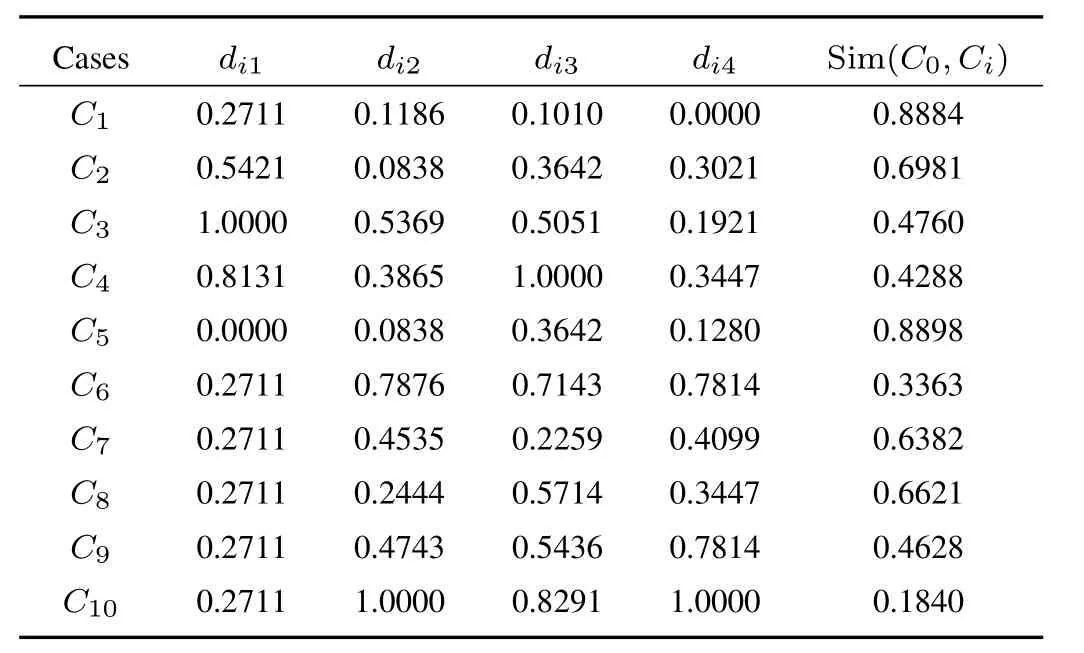
TABLE VIRESULTS CALCULATED FOR THE ATTRIBUTE SIMILARITY AND EMERGENCY CASE SIMILARITY
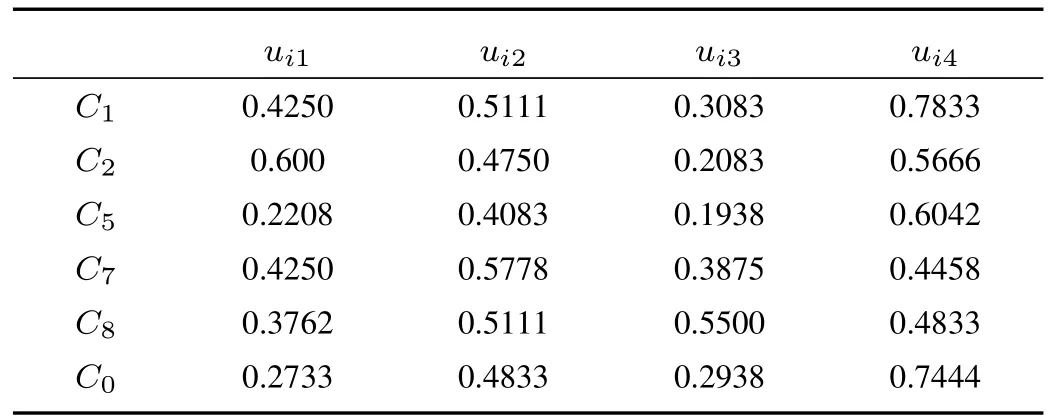
TABLE VIIUTILITY OF EVERY ATTRIBUTE FOR THE CHANGING TRENDS IN THE EMERGENCY CASE
Step 3:Select the optimal emergency alternative.According to the alternative case library and the decision attribute,the DM provided the fuzzy and multiplicative preference relations as follows.
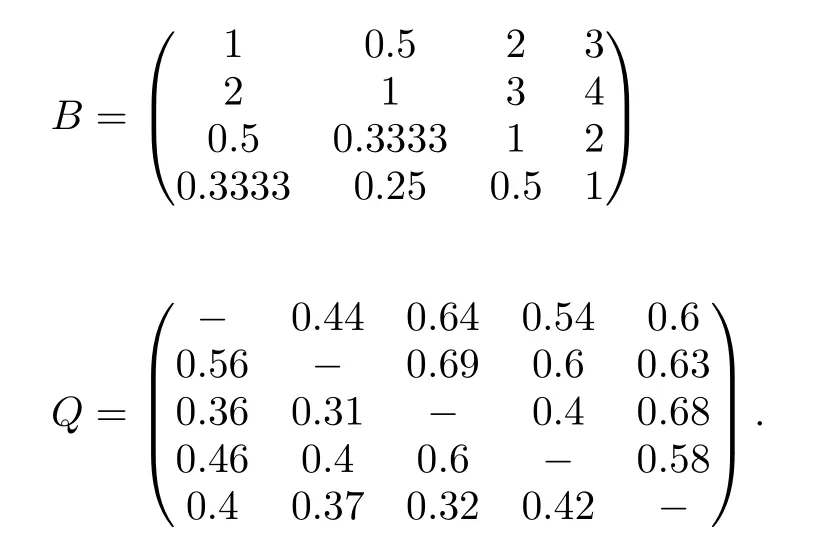
To find the best alternative for the DM,we first transformed the linguistic variables into triangular fuzzy numbers using(2),i.e.,t0= (0,0,0.25),t1= (0,0.25,0.5),t2=(0.25,0.5,0.75),t3=(0.5,0.75,1),and t4=(0.75,1,1).Next,we normalized the original decision matrix Z using(18)and(19).The normalized decision matrix Y was obtained as follows:

Based on the given fuzzy preference relation Q and(21),we obtained the following:

According to the fuzzy and multiplicative preference relations and the decision matrix information,we determined the weights of the decision attributes by solving model(22).Table VIII shows the optimal relative weights estimated for the four attributes using different combinations of subjective preferences and objective information.Finally,we obtained the overall weighted assessment values of the five alternatives using(23)and the results are shown in Table IX.

TABLE VIIIOPTIMAL RELATIVE WEIGHTS FOR THE FOUR DECISION ATTRIBUTES

TABLE IXOVERALL WEIGHTED ASSESSMENT VALUES FOR THE FOUR ALTERNATIVES
(α,β)=(0,1)and(α,β)=(1,0)represent two extreme combinations,which do not consider either the fuzzy preference relation or the multiplicative preference relation,respectively,so they should be avoided when the two preference relations must be considered simultaneously.In this situation,irrespective of how α and β are combined,the results yield the same final ranking:C1≻C5≻C2≻C7≻C8.Thus,the historical case and the target case will be more similar when the overall weighted assessment value is greater.Therefore,the desirable historical case,i.e.,C1,can be retrieved according to the results and the response plan in historical case(C1)can be considered as the optimal solution by the fire control center.
C.Comparison Analysis
We performed comparative analysis based on the results obtained using our method and other methods.
First,to obtain the most similar historical case,we used the case retrieval method described by Alptekin and Büyüközkan,which integrates CBR and the analytic hierarchy process(AHP)[25].The attribute weights produced by AHP comprised w=(0.1924,0.3014,0.2479,0.2583)and the case distance values were:dist(C0,C1)=0.0680,dist(C0,C2)=0.1628,dist(C0,C3)=0.2852,dist(C0,C4)=0.3278,dist(C0,C5)=0.0765,dist(C0,C6)=0.3622,dist(C0,C7)=0.1891,dist(C0,C8)=0.1901,dist(C0,C9)=0.2865,and dist(C0,C10)=0.4500.Therefore,the most similar historical case is case C5,which differs from the results shown in Table VI because the attribute weights are different.The method that uses AHP to determine attribute weight is objective,whereas our proposed method for determining the weight attributes is both objective and subjective.Thus,the results in Table VI are reasonable.
Second,we employed the hybrid similarity measure[4]to compute the similarity between target case C0and the historical cases Ci.We then obtained the similarity values,i.e.,Sim(C0,C1)=0.8985,Sim(C0,C2)=0.7497,Sim(C0,C3)=0.6155,Sim(C0,C6)=0.5839,Sim(C0,C6)=0.8986,Sim(C0,C7)=0.6993,Sim(C0,C8)=0.7178,Sim(C0,C9)=0.5944,Sim(C0,C10)=0.4633,and thus the case with the highest similarity was C5.This result is the same as that shown in Table VI,although this method did not consider the trends in the development of the case,the initial response time,and the implementation effect.However,the DM at the fire control center analyzed the data and found that the changes in emergency case C1were most similar to emergency case C0,where the utility similarity of emergency case C1with regard to the changing trend was 0.9418 and the change in the degree of similarity for emergency case C5was 0.9081.In addition,Table IV shows that the initial response time and implementation effects were better for emergency case C1than emergency case C5.Therefore,we can conclude that the response plan for historical case C1was the best alternative for the fire control center and it would be expected to achieve the most favorable outcome in response to the highrise building fire.
In addition,Li et al.[26]proposed a method for generating emergency alternatives based on similarity case analysis by considering the implementation effects of emergency alternatives belonging to similar cases.Thus,we also used this method to generate emergency alternatives for the high-rise fire.First,the attribute weights were determined according to the weight optimization model of Zhao and Yu[27],where the results comprised w=(0.2963,0.2702,0.1797,0.2583).Hence,the case similarities produced by this method and the similar cases included(C1,C2,C5,C7,C8).The case similarities comprised Sim(C0,C1)=0.8695,Sim(C0,C2)=0.6700,Sim(C0,C5)=0.8984,Sim(C0,C7)= 0.6525,and Sim(C0,C8)=0.6634,where the case ranking was:C5>C1>C2>C8>C7,which differed from the ranking obtained by our method.This is because our weight optimization model considers the distance as well as the preferences of DMs.We also calculated the evaluation values for each alternative implementation effect and the initial response time,which belonged to a valid similar historical case,and the values obtained were V1=0.7916,V2=0.8750,V5=0.9167,V7=0.5028,and V8=0.According to the evaluation values,this method selected case C5as the alternative to the target case C0,which differed from the result obtained using our proposed method.This is because the method proposed by Li et al.[26]does not consider the changing trends in the cases.In practice,emergencies are dynamic so it is reasonable to consider the changing trends in the cases.
D.Sensitivity Analysis
1)Impact of the Interval Probability on the Emergency Cases:We conducted the following sensitivity analysis according to the probabilities for each attribute of the target case.
As shown in Table III,there are two types of state description:a linguistic description such as g1,or an interval number such as g2,g3,g4.First,we analyzed g1.When the attribute g1was changed in every state for the target case,the utility similarity for the emergency cases were gained and are shown in Table X,which shows that the degree of similarity for the change in the emergency case was sensitive to changes in the state of attribute g1.
The states of attributes g2,g3,g4are interval numbers,so we consider g3as an example.The utility similarities of the five feasible emergency cases with different values of g3were calculated and are illustrated in Table XI,which clearly demonstrates that the utility similarities of the five feasible emergency cases varied according to different values of attribute g3.

TABLE XUTILITY SIMILARITIES FOR THE FOUR FEASIBLE EMERGENCY CASES WHEN THE STATE OF ATTRIBUTE g1VARIED
2)Impact of the Weights of the Four Decision Alternatives on the Case Ranking:We obtained different weights using various combinations of the multiplicative preference relations for the four attributes and the fuzzy preference relations for the five alternatives.When we changed the weight of the decision attribute,the overall ranking values for the historical cases also changed in the corresponding manner.The overall ranking values for the four feasible alternatives with different weights are plotted in Fig.1,which clearly demonstrate that emergency case C1was always ranked first;thus,we selected emergency case C1as the optimal alternative.

Fig.1. Impacts of the weights of the decision attributes on the emergency case ranking.
V.CONCLUSIONS
In this study,we proposed a dynamic case retrieval method by integrating subjective preferences and objective information to facilitate emergency decision making.In the proposed method,we calculate the weights of the emergency attributes using a pairwise comparison matrix based on the relative weights of the attributes.Next,we calculate the utility similarity of the emergency case with respect to changes in the attributes.An overall weighted assessment value is then calculated for the historical cases to integrate subjective preferences and objective information,and the optimal historical case(s)is retrieved according to the overall assessment value obtained.Furthermore,we conducted a case study,which demonstrated the practical utility of the proposed method.
The proposed method has some distinct characteristics compared with existing methods for generating emergency plans.In particular,the proposed method comprehensively considers the subjective preferences of the DMs as well as the historical data in the process used to generate the emergency plans.As discussed earlier,most existing methods for generating emergency plans using CBR do not consider the subjective preferences of DMs or the degree of similarity in the changes that occur in an emergency case compared with historical precedents.Therefore,the proposed method addresses these deficiencies.Our proposed method also considers the similarity in terms of the changing attributes of an emergency,whereas few existing methods consider the dynamic development of the attributes,although this is important for selecting the optimal emergency alternative.Moreover,we conducted a sensitivity analysis and the data obtained also indicated that it is important to consider this factor.
Therefore,we suggest that the proposed method can yield distinct improvements when generating emergency plans.For example,in terms of the emergency case similarity,ourmethod considers changes in the degree of the emergency,so the emergency plans obtained can respond better to the current emergency.Thus,the proposed method using CBR to integrate subjective preferences and objective information may ultimately facilitate improved decision making because it considers the similarity to previous emergency cases in order to generate the optimal emergency alternative,but it also considers the initial response time and the effects of implementing historical emergency cases,thereby obtaining a more practical emergency alternative.

TABLE XIUTILITY SIMILARITIES FOR THE FOUR FEASIBLE EMERGENCY CASES WHEN THE STATE OF ATTRIBUTE g3VARIED
In terms of future research,the proposed method can be embedded into an emergency decision support system to support DMs with effective decision making during an emergency.
杂志排行
IEEE/CAA Journal of Automatica Sinica的其它文章
- Advances in Vision-Based Lane Detection:Algorithms,Integration,Assessment,and Perspectives on ACP-Based Parallel Vision
- Deep Scalogram Representations for Acoustic Scene Classification
- A Mode-Switching Motion Control System for Reactive Interaction and Surface Following Using Industrial Robots
- Adaptive Proportional-Derivative Sliding Mode Control Law With Improved Transient Performance for Underactuated Overhead Crane Systems
- On“Over-sized"High-Gain Practical Observers for Nonlienear Systems
- H∞Tracking Control for Switched LPV Systems With an Application to Aero-Engines
